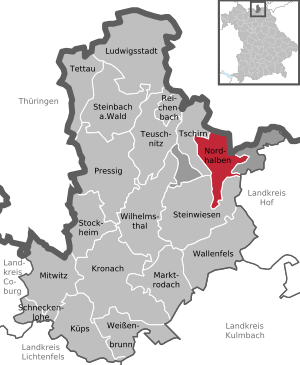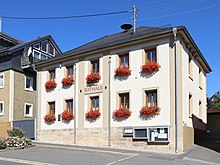Nordhalben
| coat of arms | Germany map | |
|---|---|---|

|
Coordinates: 50 ° 22 ′ N , 11 ° 31 ′ E |
|
| Basic data | ||
| State : | Bavaria | |
| Administrative region : | Upper Franconia | |
| County : | Kronach | |
| Height : | 586 m above sea level NHN | |
| Area : | 21.91 km 2 | |
| Residents: | 1622 (Dec. 31, 2019) | |
| Population density : | 74 inhabitants per km 2 | |
| Postcodes : | 96365, 96349 | |
| Area code : | 09267 | |
| License plate : | KC, SAN | |
| Community key : | 09 4 76 159 | |
| Market structure: | 13 districts | |
Market administration address : |
Kronacher Str. 4 96365 Nordhalben |
|
| Website : | ||
| Mayor : | Michael Pöhnlein (FW) | |
| Location of the market in Nordhalben in the Kronach district | ||
Nordhalben is a market in the Upper Franconian district of Kronach in Bavaria .
geography
Geographical location
Nordhalben is located in the Franconian Forest Nature Park in the Upper Rodach Valley and on the Ködeltalsperre .
Community structure
Nordhalben has 16 officially named municipal parts.
|
history
In 1154, a “castle in the northern forest” was mentioned for the first time in a document from Bishop Eberhard II of Bamberg . This was created between 1151 and 1154 on today's Schlossberg. The place Nordhalben developed around them. The castle was destroyed in 1325 and rebuilt in 1354 by the two border neighbors, the Bishop of Bamberg and the Vogt of Gera . In 1518 Nordhalben seals and market rights were transferred. During the Peasants' War the castle was destroyed again in 1525.
After the bailiffs of Gera took over the Reformation in the middle of the 16th century , the almost 200-year-old condominium over Nordhalben ended and the place became the sole property of the Bamberg bishop in 1550. The Dreiherrenstein near Nordhalben has since sealed the affiliation of the place to the Bamberg monastery . In the following year, an office building of the Bamberg bishopric was built in the village.
Between 1610 and 1620 the Protestant residents moved to the neighboring Russian town of Titschendorf . In 1633, 40 people died in the destruction of northern Halifax in the Thirty Years' War . Thanks to the Peace of Nordhalben concluded in 1635 , a special agreement between the Bamberg city of Kronach and the Prince of Reuss-Lobenstein , urgently needed food could be delivered across the Russian border to Nordhalben, which was damaged by the war.
As part of the Bamberg Monastery, Nordhalben came to the Electorate and later Kingdom of Bavaria with the Reichsdeputationshauptschluss of 1802/03 . In 1804 the place became the seat of the royal Bavarian district court Teuschnitz . Napoléon Bonaparte stayed in Nordhalben in 1806.
The schoolhouse was inaugurated in 1852. After a large fire destroyed almost the entire place in 1856, the Catholic parish church of St. Bartolomew was consecrated two years later. With the Rodachtalbahn in 1900, Nordhalben was connected to the railway network. The place was the end point of this local line from Kronach until the complete shutdown of rail traffic in 1994. The upper part of the line between Nordhalben and Steinwiesen has been operated as a museum railway since 2007 .
In 1903 the local lace school was founded, expanded in 1983 and the guest house was built. In 1986 the international lace collection was opened in the lace school.
In 1973 the Ködeltalsperre Mauthaus went into operation . With the fall of the Wall , the border crossing into the neighboring Thuringian Rodacherbrunn was opened in 1989 , the Nordwaldhalle opened in 1995 and the local historical museum opened in 2004.
religion
The inauguration of the Catholic parish church St. Bartolomäus took place in 1858. The foundation stone of the Evangelical Jubilate Church was laid in 1925.
Incorporations
On May 1, 1978, the previously independent community of Heinersberg was incorporated.
Population development
In the period from 1988 to 2018, the population fell from 2315 to 1650 by 665 or 28.7%.
politics
Market council
The market council of Nordhalben has 14 members, plus the separately elected honorary mayor.
| 2014 | |
|---|---|
| CSU | 4th |
| Free voter community Nordhalben | 7th |
| SPD | 3 |
| total | 14 seats |
coat of arms
The description of the coat of arms reads: “Divided and split above; at the top, in gold, a left-facing, red-armored black lion covered with a silver sloping left bar; in the back, in gold, the growing, black-clad rump of a bearded man with a black pointed cap, at the top of which hangs a six-pointed red star; below, in silver on green ground, four green deciduous trees side by side. ”The trunk is a heather head .
Culture and sights
Nordhalben is nationally known for its tradition of lace-making of lace , which dates back to the founding of the only remaining municipal Klöppelschule Germany in 1,903th The scenic highlight is the Ködeltalsperre . Numerous well-marked routes and long-distance hiking trails as well as the nearby Rennsteig offer hiking opportunities.
Architectural monuments
Sports
Indoor sports in the Nordwaldhalle, numerous outdoor sports opportunities, winter sports with drag lift and groomed cross-country trails.
Regular events
In the Nordwaldhalle (up to 2500 seats) there are regular entertainment and sporting events. Further event possibilities exist in the guest house. The Nikolausmarkt takes place annually on the second Advent weekend in the Nordwaldhalle. Every two years (odd years) the lace school organizes the Nordhalben lace days with fair, exhibitions and lectures. On the Sunday after Michaelmas (September 29th) the parish consecration of the catholic parish church St. Bartholomäus is celebrated. The Protestant Jubilate Church celebrates its parish festival on the third Sunday after Easter.
Soil monuments
Economy and Infrastructure
traffic
Nordhalben was the end of the now disused Rodachtalbahn . A museum railway has been operating on the section between Steinwiesen and Nordhalben since September 15, 2007 . The next active train stations are in Bad Steben , Kronach and Wurzbach . Public transport bus routes connect Nordhalben with Kronach and Hof . Junction to the federal highways 9 , 72 and 93 are about 25 kilometers away from Nordhalben and the junction to the federal highway 73 is about 50 kilometers away in Lichtenfels . The Franconian Marienweg runs through the village .
Public facilities
- Lace school
- International lace collection
- Historical local museum
- Natural adventure pool
- North Forest Hall
education
There is a primary school in town for grades 1 to 4.
literature
- Johann Kaspar Bundschuh : Nordhalben . In: Geographical Statistical-Topographical Lexicon of Franconia . tape 4 : Ni-R . Verlag der Stettinische Buchhandlung, Ulm 1801, DNB 790364301 , OCLC 833753101 , Sp. 21-22 ( digitized version ).
- Pleikard Joseph Stumpf : Nordhalben . In: Bavaria: a geographical-statistical-historical handbook of the kingdom; for the Bavarian people . Second part. Munich 1853, p. 618 ( digitized version ).
Web links
- Homepage of Nordhalben
- Entry on the coat of arms of Nordhalben in the database of the House of Bavarian History
- Nordhalben: Official statistics of the LfStat (PDF; 1.46 MB)
Individual evidence
- ↑ "Data 2" sheet, Statistical Report A1200C 202041 Population of the municipalities, districts and administrative districts 1st quarter 2020 (population based on the 2011 census) ( help ).
- ↑ Nordhalben in the local database of the Bayerische Landesbibliothek Online . Bavarian State Library
- ↑ The Dreiherrenstein near Nordhalben with a map
- ^ History of the Nordhalben trade train
- ^ Federal Statistical Office (ed.): Historical municipality directory for the Federal Republic of Germany. Name, border and key number changes in municipalities, counties and administrative districts from May 27, 1970 to December 31, 1982 . W. Kohlhammer GmbH, Stuttgart / Mainz 1983, ISBN 3-17-003263-1 , p. 690 .
- ↑ http://svc.landkreis-kronach.de/wahlenNordhalben/KW_2008/kommunalwahlen_2008.htm









